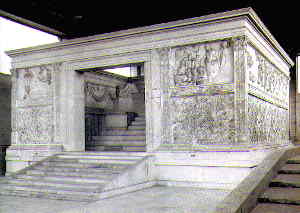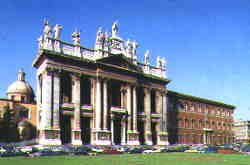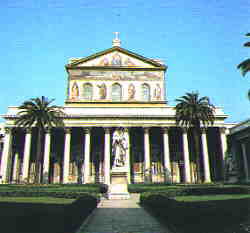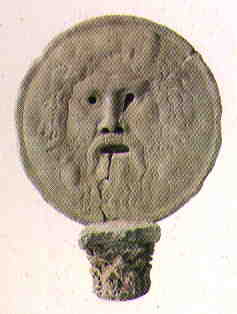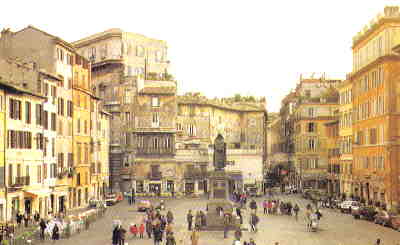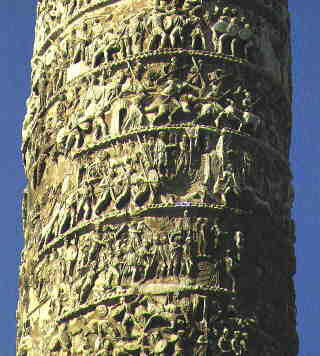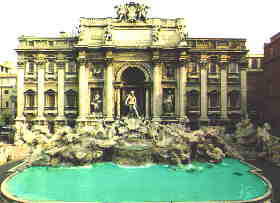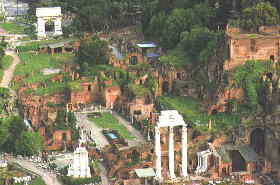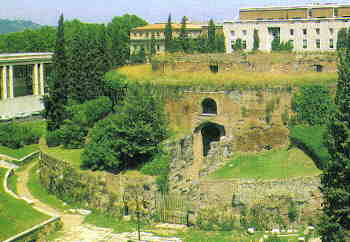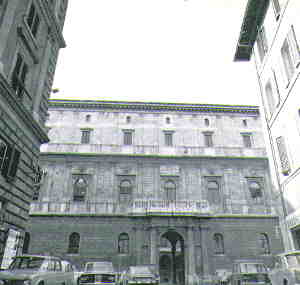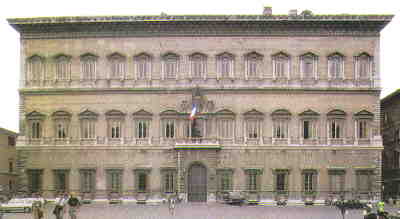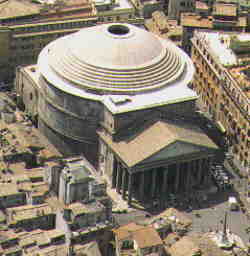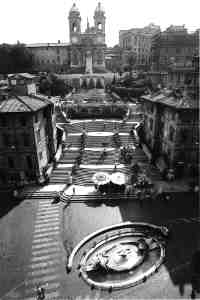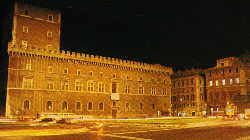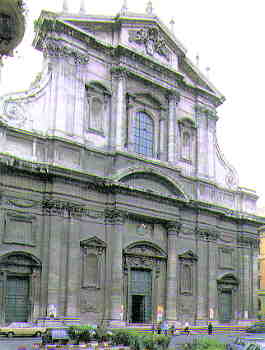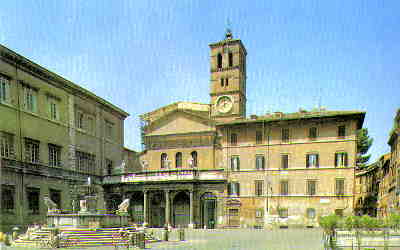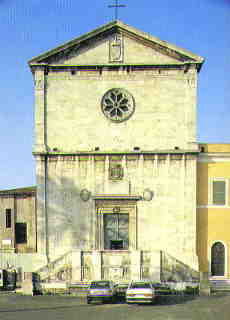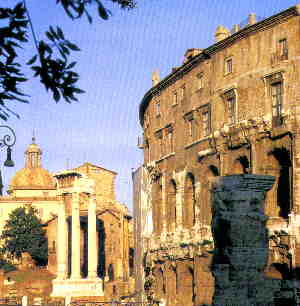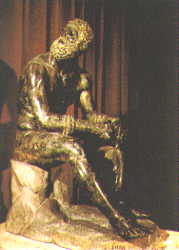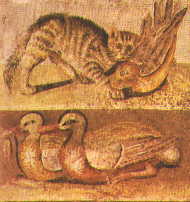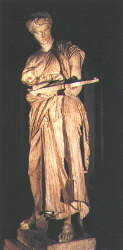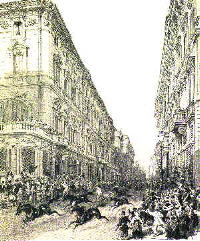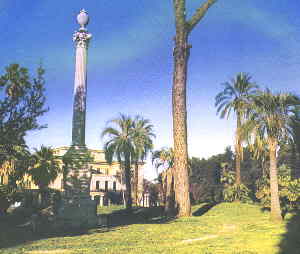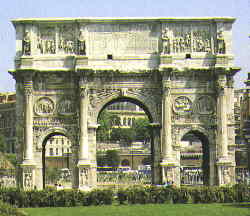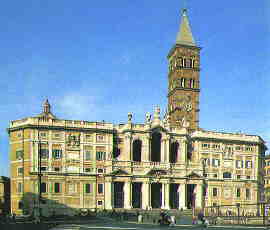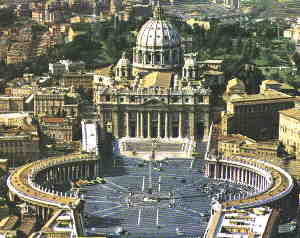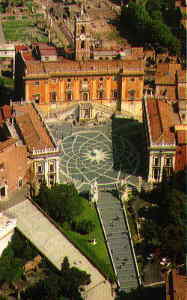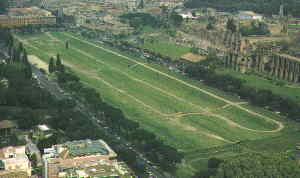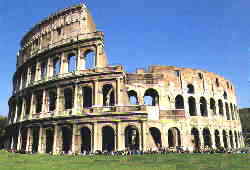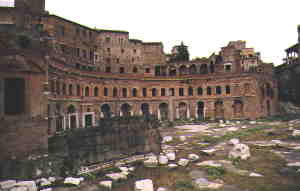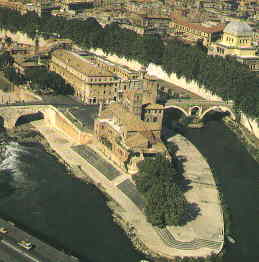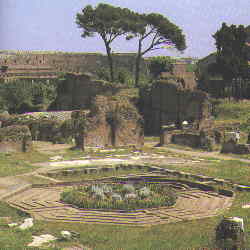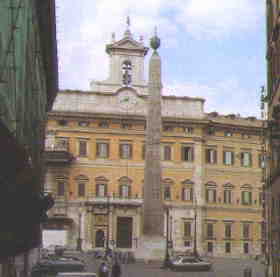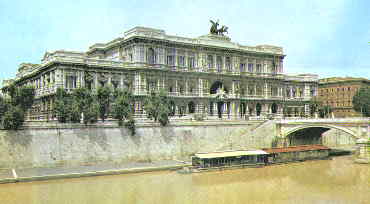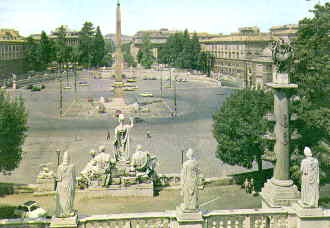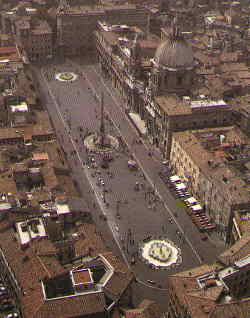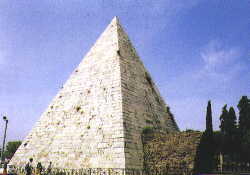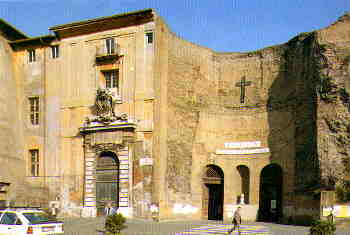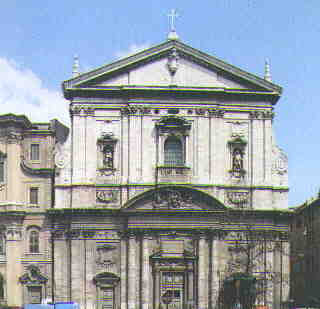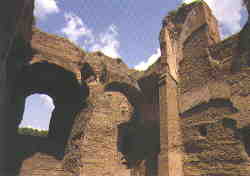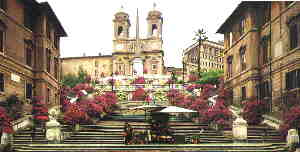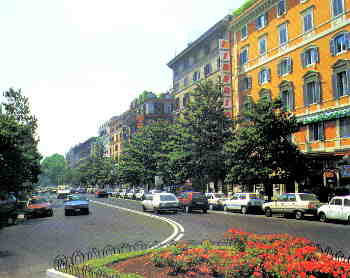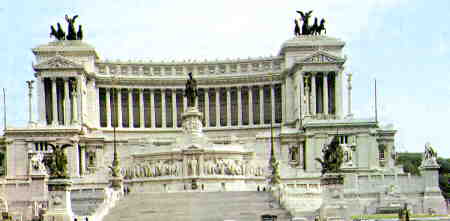성지순례ㅣ여행후기
|
로마여행(가이드 동행:공짜!!!) |
|---|
|
저는 미술이나 역사에 조예가 있지도 않을뿐더러, 이탈리아말이나 라틴어 수업을 받은 적도 없답니다. 더더군다나 유럽 성지순례도 못가보아서... 혹, 저의 부족함으로 인한 잘못된 내용 설명이 있다면, 발견하시는 즉시 제게 알려 주세요. 교정하여 놓겠습니다.
각설하고, 한번도 로마에 가본적 없는 가이드를 따라 떠나는 이상한 여행을 떠나 볼까요?
엇, 벌써 로마 도착? 역시 제트기를 타구 오길 잘했어요.
001. 아라 빠시스(평화의 제단) ARA PACIS
BC 9세기경, 이 제단은 갈리아와 스페인 평정 후 찾아온 대평화를 기념하기 위해 지어졌습니다. 실제 제단은 이 직사각형 모양의 아라 빠시스 안에 위치해 있답니다. 그 안에서 가장 중요한 볼거리는 아우구스뚜스와 아그리빠, 율리우스, 그리고 티베리우스를 묘사한 대부분 복원된 낮은 돋움 세김 조각이지요. 비아 디 리페따를 따라 이어진 벽면 기저부에는 청동으로 만들어진 아우구스뚜스의 증언판이 있어요. 역사가들은 그것을 레스 제스때 (성취 업적)라고 부른답니다.
In 9 BC, this altar was built to commemorate the great peace after the Gallic and Spanish campaigns. The Ara consists of a rectangular enclosure inside of which is found the actual altar. The most significant scene in the mostly restored bas-relief is the one depicting Augustus, Agrippa, Julius, and Tiberius. Along the base of the wall that runs along the Via di Ripetta is a bronze reproduction of Augustus’ testimonial plaque, called by historians the "Res Gestae" (Deeds accomplished).
002. 라떼란 바실리카 성 요한 성당 St. John in Lateran Basilica
라떼란 안의 성 요한 성당은 로마에 있는 성당으로서 로마와 전세계 교회들의 어머니 격이 되는 곳이랍니다. 실베스텔 교황(314-335) 시절 콘스탄티누스 황제가 세웠지요. 이 성당은 훼손과 재건축을 여러번 받았답니다. 현재의 바실리카는 17세기로 거슬러 올라간다고 하네요.
St. John in Lateran is the Cathedral of Rome, the mother of all churches in Rome and in the world. Founded by Constantine, during the time of Silvester (314-335) it has been destroyed and rebuilt many times. The current basilica dates from the 17th century.
003. 성바오로 바실리카 St. Paul’s outside the walls Basilica
오스티엔세 도로를 따라 약 2km 가량 가면 성 바오로 바실리카가 있답니다. 이 건물은 이상인들의 사도께서 처음 묻히셨던 곳 위에 세워졌고 324년에 축성되었답니다. 성 바오로 사도의 무덤을 경배하던 첫번째 장소 위에 세워진 이 건물은 콘스탄티누스 황제에 속해 있었지요. 발렌티아노 2세 황제, 테오도시우스와 아카디우스 황제가 보다 큰 바실리카로 개축했답니다. 1823년 화재로 전소되었으나, 복원되어 교황 비오 9세에 의해 축성되었지요.
About 2 Km away on the Via Ostiense rises the Basilica St. Paul outside the walls, built over the burial place of the Apostle of the Gentiles and consecrated in 324. The building of the first place of worship over St. Paul’s tomb has been attributed to the Emperor Constantine. A larger basilica was erected by the Emperors Valentiniano II, Theodosius and Arcadius. Destroyed by fire in 1823, it was rebuilt on the same foundations and consecrated by Pope Pius IX
004. 보카 델라 베리따스(진실의 입) (BOCCA DELLA VERITA)
이는 진실의 입이라 불리는 마스크입니다. 전해져오는 이야기에 의하면, 이 입 속에 손을 넣고 거짓 맹세를 하는 사람은 손을 빼낼 수 없다고 합니다. 이 마스크는 코스메딘 교회 성마리아 아트리움에 위치해 있지요. 그레고리 펙, 오드리 햅번 주연의 로마의 휴일의 한 장면이 떠오르시지 않나요? 정말 로맨틱한 만남과 이별이었지요...
It is a marble mask called Mouth of Truth (Bocca della Verita). According to popular belief it was said that any one putting his hand in this mouth and swearing falsely, could not withdraw it. The mask is situated in the atrium of St. Mary’s in Cosmedin church.
005. 꽃 들판 CAMPO DE’ FIORI (The flower field)
전해오는 이야기에 의하면, 이러한 이름은 폼페오의 연인이었던 플로라(꽃이라는 뜻)로부터 유래한다고 합니다. 그러나 보다 신빙성 있는 이야기는 1300년대 후반 이 광장이 짧은 시기동안 버려졌고 들판이 되었던 사실에서 유래했다는 설입니다. 1869년 이래 이 곳은 활기하고도 다채로운 시장의 본향이 되었답니다. 중앙에는 지오르다노 브루노를 위한 비석이 세워져 있습니다.
Tradition would have it that the name comes from Flora, Pompeo’s lover, but more likely it comes from the fact that in the late 1300’s, the piazza was abandoned for a brief period, and became a meadow. Since 1869 it has been the home to a vibrant and colorful market. In the center rises the monument to Giordano Bruno, who in 1600 was burned here at the stake as a heretic for contending that the universe has no center.
006. 콜로나 트라이아나 COLONNA TRAIANA
이 기둥은 19 블록의 대리석으로 되어 있죠. 기둥을 따라 나선형으로 인물 조각들이 새겨져 있답니다. 무슨 조각들일까 궁금하시죠? 트라얀 황제의 다치안 전쟁을 다큐멘타리로 만든 조각들이랍니다. 이 기둥에서 우리는 트라얀 황제가 지은 다리들과 그가 공격한 요새들과 군대들과 도망가고 있는 적들이 아로새겨져 있습니다.
The column consists of 19 blocks of marble with a helicoidal band of figures spiraling up it, documenting the Dacian War of Emperor Trajan.On this column we see the bridges Trajan built, the forts he attacked, the camps he destroyed, and the enemy he put to flight.
007. 트레비 분수 (폰타 디 트레비) FONTANA DI TREVI
이 아름다운 분수 교황 글레멘스 12세 시절 (1735년) 건축가 살비가 만들기 시작해서, 베르니니 학교 예술가들 여럿이 그 장식을 추가했답니다. 이 분수는 커다란 궁전(팔라쪼 폴리) 바로 앞에 위치해 있답니다. 팔라쪼 폴리는 바위무지 위에 세긴 낮은 돋움 세김들과 동상들로 장식되어 있지요. 이 분수는 그 수려한 자태뿐만 아니라 전해 내려오는 전설 때문에도 유명합니다. 분수 물을 마시거나 연못에 동전을 던지는 사람은 이후에 분명히 또다시 로마를 방문하게 된다는 전설이지요.
The fountain was built by the architect Salvi (1735) in the time of Clement XII, and decorated by several artists of Bernini’s school. It is the front of a large palace (Palazzo Poli) decorated with statues and bas-reliefs on heaps of rocks. The fountain is not only celebrated for its excellent water but for the legend that whoever drinks it or throws a coin in the fountain, will assure his return to Rome.
008. 로마 광장(로만 포럼) ROMAN FORUM
로마 광장은 공화정 시절 시민 생활과 경제 생활의 중심지였고 그러한 역할은 로마 제국 시대까지도 이어갔답니다. 기념비들은 의사당, 제국 광장, 콜롯세움과 팰러타인 사이에 위치해 있지요.
The Roman Forum was the centre of the civic and economic life of Rome in the Republican era and kept its prominent role even in the Imperial age. The monumental complex lies between the Capitol, the Imperial Forums, the Colosseum and the Palatine.
009. 아우구스투스의 모솔레움 THE MAUSOLEUM OF AUGUSTUS 기원전 27년에 건축된 모솔레움은 상당부분 건축 자재로 도단당했답니다. 그래서 오늘날 이렇게 일부분만 남아 있지요. 그래서 그후로는 포도밭이나 교수형을 행하던 광장, 야외 공연장, 극장으로 사용되었습니다. 원래는 에트루스칸 봉분(무덤) 유형의 44미터 높이였답니다. 그 위에 편백나무들이 심어져 있었고, 청동 동상들이 서 있었습니다. 그 안에는 아우구스투스의 유품들을 위한 공간이 있었다고 하네요. 중앙 기둥 주위에는 귈리오-클라우디아 집안의 유력인사들의 무덤들이 있습니다.
Built in 27 BC, the Mausoleum was pillaged as a source of building materials (the many evident thefts reduced it to its current dimensions). It then became a vineyard, a hanging garden, an amphitheater, a theater, and an auditorium. It was originally 44 meters high, in the form of an Etruscan tumulus, planted with cypresses and crowned with a bronze statue, inside of which there was a space for the remains of Augustus. Around the central pillar were the graves of the more distinguished members of the Giulio-Claudia family.
010. 팔라쪼 델라 칸첼레리아(칸첼레리아 궁)
PALAZZO DELLA CANCELLERIA
16세기에 라펠레 리아리오 추기경이 이 건축을 명하였다 합니다. 그후 이 궁전은 리아리오 집안으로부터 인수하여 사도 참사원으로 사용했습니다. 오늘날 이 곳은 싸크라 로타(거룩한 바퀴) 법정이 들어서 있답니다.
The cardinal Raffaele Riario ordered this built at the beginning of the sixteenth century. The palace was then taken away from the Riario family and made the seat of the Apostolic Chancellery. Today it houses the court of the Sacra Rota (Holy Wheel).
011. 팔라쪼 파르네세(파르네세 궁) PALAZZO FARNESE
이 궁전의 건축은 1517년, 알레산드로 파르네세 추기경(후의 교황 바오로 3세)이 시작했다고 합니다. 디자인은 다 상갈로가 했구요. 시초에 이 건물을 짓던 건축가가 사망하지, 그 임무는 미켈란젤로에게로 넘겨졌답니다. 그는 커다란 처마장식과 중앙 발코니를 건축에 덧붙였지요. 이 궁전 앞에는 파아짜(광장)가 있고요, 이 궁전은 현재 프랑스 대사관이 들어와 있습니다.
Construction on this palace was begun in 1517 by the cardinal Alessandro Farnese ( the future Pope Paulus III), after a design by A. da Sangallo the Younger. Upon the death of the architect, the task was handed down to Michelangelo, who gave it the grand cornice and the central balcony. The palazzo, which faces a piazza bearing its name, is today the home to the French Embassy.
012. 판테온 PANTHEON
현관 처마 머리에 새겨져 있는 글자 "M. Agripa L. F. Cos tertium fecit"는 기원전 27년 아그리빠가 세운 신전, 율리아 가문의 수호신전을 지칭합니다. 그러나 아그리빠가 세운 건축물은 기원후 80년에 화재로 전소되었지요. 최근의 연구는 현재의 판테온이 헤이드리안 시대에 재건축된 것이라는 증거를 내놓고 있답니다. 내부 지름은 43.40 미터이고, 높이가 지름과 같은 높이랍니다. 무척 규모가 크네요. 공기와 빛이 건물 지붕에 있는 지름 8미커 92 센티미터 크기의 원을 통해 지금도 들어온다고 합니다.
The inscription on the architrave of the portico "M. Agrippa L. F. Cos tertium fecit" refers to a temple erected by Agrippa in 27 B.C. to the tutelary divinities of the Julia family. In reality Agrippa’s building was destroyed by a great fire in A.D. 80. Recent studies have proven that the present Pantheon is a reconstruction of the temple from the time of Hadrian. The interior measures 43,40 metres in diametre, and the same in height. Light and air still enter through the opening at the top (a circle of 8m. 92cms in diameter).
013.스파그나 광장(피아짜 디 스파그나) PIAZZA DI SPAGNA
단번에 여러분을 압도하는 것이 있습니까? 기념비적인 계단이 보이시죠? 이 계단은 1772년에 만들어진 것인데요, 구불구불한 라인이 언덕 경사를 따라 아주 잘 어울리게 이어져 있답니다. 이 계단 맨 아래 끝에는 바로 베르니니가 만든 ’작은 배의 연못’이 있답니다.
The first thing that strikes one is the monumental flight of steps (1772) whose sinuous lines harmoniously follow the slope of the hill. At its feet is the Fountain of the Little Boat by P. Bernini.
014. 베네치아 광장(베네치아 피아짜) PIAZZA VENEZIA
야아! 멋있는 야경이네요. 이 건물이 바로 베네치아 궁전이랍니다. 이 궁전 앞의 광장은 베네치아 궁전으로부터 그 이름을 따서 베네치아 광장이라고 하죠. 교황 바오로 2세께서 추기경 시절이던 1445년 이 궁을 지으셨다고 합니다. 후에 비토리노 엠마누엘 2세가 베네치아 궁을 이전시키고, ’아씨쿠라치오니 게네랄리 디 베네치아’ 궁전을 새로 지으면서 이 광장은 재정비되었답니다.
This square took it’s name from Venezia Palace, (shown in the picture). Pope Paolo II built the Palace in 1455 while he was only a cardinal. The square was rearranged during the works at Vittorio Emanuele II monument: Venezia Palace was moved and in front of it was built a new one, the "Assicurazioni Generali di Venezia" Palace.
015. 성 이냐시오 성당 S.IGNAZIO
교황 그레고리오 15세께서 로욜라의 이냐시오 성인을 기념하여 이 성당 건축을 명하셨다고 합니다. 이 성당은 1621년부터 1685년까지 건축되었땁니다. 이냐시오 성인이 누구냐구요? 바로 예수회의 창립자시죠. 우리나라에는 서강대가 바로 예수회에서 세운 학교랍니다. 로욜라의 이냐시오 성인은 1622년에 시성되었습니다. 건축을 맡은 안드레아 포쪼는 실제적인 둥근 천장 지붕을 덮는 대신, 트롬페 뢰일 천장 그림을 디자인했답니다. 그 덕분에 보는 사람은 실제로 둥근천장 지붕 밑에 앉아 있는 듯한 느낌을 받는답니다.
Pope Gregory XV ordered this church built between 1621 and 1685 in honor of St. Ignatius of Loyola, founder of the Jesuits, canonized in 1622. Instead of the actual cupola, which was never built, Andrea Pozzo designed and painted a trompe l’oeil ceiling which gives the viewer the impression of sitting beneath a real cupola.
016.트라스테베레의 성 마리아 바실리카 S.MARIA IN TRASTEVERE
현재 여러분께서 보고 계시는 모습의 바실리카는 교황 인노첸시우스 2세(1138-1148) 시절에 지어진 건축이랍니다. 이 건축 재료들은 카라칼라 목욕탕에서 캐온 것들이었다고 하네요. 이 자리에 최초로 세워진 성당은 교황 율리우스 1세 때(기원후 4세기 중반)로 거슬러 올라갑니다. 현관에 들어서면서 아름다운 대리석과 조각들에 감명받으실 겁니다. 또한 원래 바실리카와 까따콤바 안에 있던 비석들도 보실 수 있습니다.
The present day basilica was built under Pope Innocentius II (1138-1148), out of materials plundered from the Baths of Caracalla. The first church on this site dates back to Pope Julius I (the middle of the 4th century AD). Beautiful marbles and sculptures can be admired in the portico, as well as inscriptions which originate from inside the basilica or from the catacombs.
017. 몬토리오의 성 베드로 성당 S.PIETRO IN MONTORIO
이 성당은 아마도 19세기에 세워진 것이겠지만, 그 디자인은 15세기 끝나기 전 20년동안으로 거슬러 올라간답니다. 건물 정면은 고딕 양식의 로젯(작은 장미꽃) 문양이 특징적이죠. 이 성당 안에는 바사리와 기안 로렌조 베르니니 등이 그린 그림들이 걸려 있습니다. 건물들의 중앙에는 성 베드로의 십자가가 마지막으로 위치했던 곳을 기념하는 의미로 브라만테 경당이 우뚝 서있답니다.
Although this church was perhaps founded in the ninth century, the design is dated to the last twenty years of the fifteenth century. The facade bears a characteristic gothic rosette. Inside are paintings by Vasari and Gian Lorenzo Bernini among others. At the center of the cloisters rises the temple of Bramante, erected on the spot which is purported to be the final resting place of the cross of St. Peter.
018. 마르셀루스 극장 THEATER OF MARCELLUS
케사르가 짓기 시작해서 그후 아우구스투스가 그의 조카이자 양자인 마르셀루스를 기억하여 헌정한 건물입니다. 이 건축물은 고대 로마의 가장 웅장한 극장들 중 하나랍니다. 15,000여 명의 관중을 수용할 수 있지요. 후에 이 극장은 건축 자재로 사용되기도 하다가, 중세에는 피엘레오니 가문에 속한 요새로도 쓰였지요. 그후 건축가 페루찌가 보수하여 귀족 사벨리 가문을 위한 화려한 르네상스식 궁으로 변용되기도 했습니다.
Begun by Caesar and dedicated thereafter by Augustus to the memory of his nephew and son-in-law Marcellus, this was one of greatest theaters in ancient Rome. It could hold around 15,000 spectators. It was used as a source of building materials, then as a medieval fort belonging to the Pierleoni family. It was then transformed by Peruzzi the architect into a sumptuous renaissance palazzo for the noble Savelli family.
019-021. 로마 국립 박물관 National Museum of Rome
The National Museum of Rome, which possesses one of the world’s most important archaeological collections, is housed in three different facilities: the Baths of Diocletian, which include the Octagonal Hall, the Palazzo Massimo, and the Palazzo Altemps.The complex restructuring and renovation effort is partially completed, but work is still under way. For this reason, only a portion of the Museum’s exhibitions can currently be visited.
로마 국립 박물관은 전세계에서 가장 중요한 건축학적 전시물들을 소장하고 있습니다. 소장품들은 세 건물에 나뉘어 전시되고 있지요. 바로 디오클레티안 목욕탕들인데요, 여기에는 8각형 모양의 강당(옥타고날 홀)과 마시모 궁(팔라쪼 마시모), 알템프스 궁(팔라쪼 알템프스)가 포함되어 있습니다. 로마 국립 박물관을 보수하고 개축하는 작업이 부분적으로만 완료된 상태입니다. 여전히 그러한 작업이 진행 중이죠. 그 때문에, 현재는 박물관 일부분 관람만 허용되고 있답니다.
The historic headquarters of the Museum is the Baths complex built by Diocletian between the last years of the third century A.D. (the dedicatory inscription dated 306 A.D. is conserved in a fragmentary state in the Museum).
로마 국립 박물관의 역사적으로 유서깊은 본부라 할 수 있는 곳이 디오클레티안이 지은 목욕탕 건물들이랍니다. 그 건축물들은 기원후 3세기 말에 지어졌지요. 박물관 전시물중에는 기원후 306년이라 세겨진 건축물 조각을 볼 수 있답니다.
The building of the Baths, the largest in the ancient world, included many rooms besides the traditional calidarium, tepidarium and frigidarium-which were designed to hold 3,000 people at the same time. Ther was a natatio or frigidarium for swimmers (large open air swimming pool) and various other rooms, meeting rooms, libraries, nympheums, dressing rooms, concert rooms and rooms for physical exercises etc.
목욕탕들의 건물은 고대 세계에서 제일 큰 규모인데요, 여기에는 많은 별실들이 딸려 있답니다. 전통적인 열탕과 온욕탕, 냉탕은 동시에 3,000명을 수용할 수 있도록 디자인되었습니다. 또한 커다란 야외 수영장과 다양한 별실들과 회합실, 도서관, 의상실, 님페움, 콘서트 룸, 신체 단련실들도 있었지요. 우리, 로마 국립 박물관의 소장품 몇가지를 감상해 볼까요?
019. 쉬고 있는 권투선수 Boxer at Rest
020. 칠면조를 공격하고 있는 고양이의 모자이크 그림
Mosaic of cat attacking a turkey
021.안찌오로부터 온 어린 소녀 Young girl from Anzio
022. 코르소 거리 VIA DEL CORSO
이 거리는 거의 일 마일가량 뻗어 있는 도로랍니다. 포폴로 광장 오벨리스크로부터 출발해서 비토리오 앰마누엘 2세 기념비에서 끝이 나는 길이죠. 1700년대 동안, 이 코르소 거리에 줄지어 들어서 있던 많은 까페들 덕분에 이 거리는 지성인들과 예술가들과 정치인들이 드나드는 중심가가 되었다고 합니다. 19세기 중반에는 패션 의상실, 서점, 신문사 등이 들어서면서 다변화 되어 오늘날 우리가 볼 수 있는 모습의 거리가 되었습니다.
This street, which stretches almost a mile, starts at the Obelisk of the Piazza del Popolo and ends at the Monument to Vittorio Emanuele II. During the 1700’s, thanks to the many caffes that lined the Corso, it became a center of intellectual, artistic and political life. In the mid nineteenth century there sprang up a multitude of fashion boutiques, book stores, and newspaper offices that give the Via its present-day character.
023. 톨로니아 별장 VILLA TORLONIA
1802년 쥬세페 발라디에가 짓기 시작한 이 별장은 20세기에는 뭇솔리니가 살던 집이기도 했습니다. 1978년부터 대중을 위한 공원 시스템의 일부가 되었지요. 그러나, 현재 이 별장은 훼손에 의해 손상된 부분이 상당합니다. 공원 아래에는 유태인 까따꼼바가 있는데요, 기원후 3-4세기에 만들어진 것으로 보이는 2개의 공동묘지가 있지요. 그 벽은 히브리 상징들과 그림들로 장식되어 있습니다.
Begun by Giuseppe Valadier in 1802, this was the home of Mussolini in the twenties. It became a part of the public park system in 1978. Today it has deteriorated due to vandalism. Beneath the park there are Jewish catacombs, made up of two cemeteries dating back to the 3rd and 4th centuries AD. The walls are decorated with ornate Hebraic paintings and symbols.
024. 콘스탄티누스 문 THE ARCH OF COSTANTINE
기원후 315년 예전부터 존재하던 건축 자재를 이용하여, 로마의 의원들과 시민들이 이 아치형 문을 건축하였습니다. 이 문은 콘스탄티누스 황제의 10번째 기념일과 312년 폰테 밀비오 전쟁에서 막센티우스에게 거둔 그의 승리를 기념하여 세워진 것입니다.
The People and Senate of Rome built this arch out of pre-existing materials in 315 AD for both the tenth anniversary of the great emperor, and in honor of his victory over Maxentius at the battle of Ponte Milvio in 312.
025. 성 마리아 마죠르 바실리카 St.Mary Major Basilica
성 마리아 마죠르 바실리카는 복되신 동정 성모 마리아께 봉헌된 수많은 교회들 중에 가장 웅장한 건축물입니다. 이 성당은 수차례의 장식을 부가하였음에도 불구하고 원형이 그대로 보존되어 있는 유일한 로마의 바실리카랍니다. 전설에 의하면, 이 성당은 기원후 352년 복되신 동정 성모 마리아께서 발현하신 후 지어졌다고 합니다. 성 마리아 대 바실리카는 ’리베리아나’라고도 불리고 있는데요, 그러한 명칭은 교황 식스투스 3세(432-440) 시절로 거슬러 올라가죠.
St. Mary Major is the greatest of many churches dedicated to Our Lady; it is the only Roman basilica which, in spite of several additional decorations, has retained its original shape. It was built, as the legend goes, in 352 A.D. after an appearance of the Blessed Virgin. The basilica, also called "Liberiana", dates from the time of Pope Sixtus III(432-440).
026. 바티칸 바실리카의 성 베드로 대성전
St.Peter’s in the Vatican Basilica
이 눈부신 광장과 여러 기둥들은 거장 베르니니의 섬세한 최고 작품입니다. 이 곳은 그리스도교 세계로 들어가는 입구 역할을 하고 있지요. 웅대한 돔형 지붕 보이시죠? 바로 미켈란젤로의 작품이랍니다. 이 바실리카 건축은 수많은 어려움과 장애에 부딪쳤었는데요, 결국 미켈란젤로와 지아꼬모 델라 포르타, 그리고 도메니꼬 폰타나에 의해 건축이 진행되었지요. 바실리카는 팔레스티나-그리스도 교회의 기반 위에 우뚝 서있답니다. 바로, 전승에 의하면 성 베드로 사도께서 순교하신 곳이기 때문이지요.
The splendid square and colonnade, Bernini’s finest work, form a superb entryway to the greatest church of Christendom, dominated by the magnificent Dome of Michelangelo. The construction of this basilica, plagued by numerous obstacles and problems,was carried out by Michelangelo, Giacomo della Porta and Domenico Fontana. The basilica rises over the foundations of a paleochristian Church, which, according to tradition, was built over the tomb of the Martyred Apostle Peter.
027. 캄피도글리오 광장 PIAZZA DEL CAMPIDOGLIO
이 눈부신 광장도 미켈란젤로가 만들었답니다. 이 광장 양편에 방사형으로 위치한 궁전들 보이시죠? 그 궁들도 미켈란젤로의 작품이랍니다. 방사형으로 위치해 있기 때문에 광장 모양이 참 독특해요. 광장 끝에 웅장한 계단 보이시죠? 바로 ’코르도나타’라 불리는 계단이랍니다. 역시 미켈란젤로가 디자인하고 건축했다고 합니다. 이 계단은 1536년 차알스 5세 황제의 개선 행진을 위해 특별히 만들었다고 해요. 중앙부 건물 앞에 동상을 올려 놓는 지금은 텅빈 커다란 기단이 보이시죠? 미켈란젤로는 그 기단 위에 말을탄 마르쿠스 아우렐리우스 황제(161-180) 동상을 세워 놓았는데요, 그 동상은 1981년 섬세한 복원 작업을 위해 옮겨져 지금은 박물관 안에 있답니다.
This splendid square was conceived by Michelangelo, who also designed the two palaces on the opposite sides of the square, whoose divergence creates a widening perspective which is most effective. It is reached by the grand flight of steps known as the "Cordonata", built to a design by Michelangelo especially for the triumphal entry of the Emperor Charles V in 1536. Michelangelo placed on a new pedestal the equestrian statue of Marcus Aurelius (161-180), removed in 1981 for some delicate restoration and situated on the ground floor of the Museo
028. 막시무스 경주 트랙 THE CIRCUS MAXIMUS
이 계란형으로 만들어진 트랙은 길이만도 거의 600 미터인데요, 거의 모두 흙으로 차여 있지요. 원래는 경주 트랙이었답니다. 에트루스칸 왕들이 다스리던 시절(아마도 타르퀴니오 프리스코 왕 때로 추정됨)에 만들어졌다고 합니다. 아우구스투스는 황제 시대의 벽돌 구조물로 장식을 했었는데요, 후에 트라얀이 재건하고, 카라칼라가 증축했고, 콘스탄티누스 황제가 복원했답니다. 콘스탄티누스 황제 시절에 이 경주 트랙은 200,000명 이상의 관중들을 수용할 수 있었다고 합니다. 오늘날은 겨우 그 윤곽만 남아 있을 뿐입니다. 이제는 대중들을 위한 공원으로 사용되고 있지요.
This oval basin, nearly 600 meters long, is almost entirely filled in with dirt. It was once a race track. It was made in the time of the Etruscan kings (presumably Tarquinio Prisco). Augustus adorned the brick structure with an imperial stage, which was rebuilt by Trajan, enlarged by Caracalla and restored by Constantine. During the reign of Constantine, the Circus could hold more than 200,000 spectators. Today only the outline remains (the area it occupied is now a public garden).
029. 콜롯세오 COLOSSEO
콜롯세오의 본래 이름은 안피테아트룸 플라비움입니다. 이 건물은 베스파시아노 황제가 건축하였고 기원후 80년에 완공되었답니다. 고대에 이 곳은 ’나우마키에’(해전), ’무네라’(검투사들의 싸움터), ’베나티오네스’(동물 사냥) 등을 관람하던 장소였다고 합니다. 87,000명을 수용할 수 있지요. 영화 쿠오바디스에서 그리스도교인들이 사자들에게 잡아먹히는 장면이 눈에 선합니다.
The original name for the Colosseo is the Anfiteatrum Flavium. It was built by emperor Vespasiano and inaugurated in 80 A.D. In ancient times it was the site of the "Naumachie" or navy-battles, the "Munera" or gladiator-fights,and the "Venationes" or wild animal-hunts.It could hold up to 87.000 people.
030. 제국 광장(임페리알 포럼) IMPERIAL FORUMS
케사르와 아우구스투스, 팍스와 트라얀의 광장(트라얀의 기둥을 포함함), 그리고 트라이아누스 시장들은 로마 제국의 공화정 시기를 특징짓지요. 이들은 제국 광장의 건축학적 영역들을 구성하고 있답니다. 좀 설명이 어렵죠? 저도 건축에 대해서는 그리고 유적들의 실물에 대해서는 잘 모른답니다. 그러려니 하면서 저도 설명을 하고 있어요.^^
Forum of Caesar, Augustus, Pax and Trajan (including Trajan’s Column) and Traianus’ markets, mark the passage from the Republic to the period of Empire and constitute the archaeological area of the Imperial forums.
031. 티베리나 섬 ISOLA TIBERINA
그리이스의 의학의 신인 에스쿨라피우스의 사원이 있었던 유명한 곳이랍니다. 이곳은 당시 병자들의 순례지의 중심이었죠. 이 섬에 성 바르톨로메오 교회를 세웠답니다. 기원전 62년에 세워진 폰테 파브리치오는 여전히 현재에도 잘 보존되어 있습니다. 기원전 46년에 건축된 폰테 체스티오가 이 섬과 도시를 연결해 주고 있지요.
On the famous temple of Esculapius, the Greek god of medicine, once the centre for pilgrimages of sick persons, rises the church of St. Bartholomew of the Island. The Ponte Fabricio, erected in 62 B.C. still almost intact today, and Ponte Cestio (46 B.C.) unite the island to the city.
032. 팰러타인 언덕 THE PALATINE HILL
로마 도시 생활의 첫 중심지였던 이 언덕은 그후 로마 제곡의 본부가 되었다고 합니다. 이 언덕에는 파르네세 별장이 우뚝 서있구요, 많은 정원과 계단 등 로마 시대의 건축들이 상당히 많이 남아 있답니다. 이 언덕 주위에는 르물루스가 자신의 도시를 구분짓는 신성한 진흙 경계 그어져 있다고 합니다.
The hill which was the first nucleus of city life in Rome became thereafter the Imperial Headquarters. It is surmounted by the Villa Farnese, which, with its many gardens and staircases, covers much of the hill, and hence a good deal of the architectural remains of the Roman age. It was in the dirt around the base of this hill that Romulus drew the sacred line that outlined the confines of his city.
033. 몬테시토리오 궁 PALAZZO DI MONTECITORIO
1871년 이래 이 궁은 의회 건물이었습니다. 지안 로렌조 베르니니와 카를로 폰타나와 데트네스토 바실레가 이 궁을 개축하고 많이 변모시켜 오늘날에 이르고 있답니다. 이 궁 안은 로사이, 카라, 드 키리코, 비아니, 볼디니, 캄피글리, 등의 미술 작품들이 들어서 있고, 무엇보다도, 파올로 베로네세 유파가 그린 ’가나의 결혼식’ 그림이 주목되죠.
Since 1871 this was the house of Parliament. The building went through many changes and restorations by Gian Lorenzo Bernini, Carlo Fontana and Ernesto Basile before arriving at its present-day appearance. Inside are works by Rosai, Carra’, De Chirico, Viani, Boldini, Campigli and, among the paintings, "The marriage of Cana" by the school of Paolo Veronese.
034. 정의의 궁 PALAZZO DI GIUSTIZIA (The Hall of Justice)
그 거친 선들과 과도한 장식 때문에 ’팔라짜시오’ 즉 ’거대한 나쁜 궁전’이라고 알려진 이 궁은 오늘날 대법원이 위치해 있는 장소랍니다. 이 건축물은 1888년부터 1910년까지 구글리엘모 칼데리니가 지었답니다. 이 궁은 온천의 침전물로 조성된 거대한 암석 덩어리 안에 만들어졌기 때문에 배수 구멍이 생겼답니다.
Known best as the "Palazzaccio" or "Big Bad Palace" due to its harsh lines and excessive decoration, today it is the location of the Supreme Court of Appeals. It was built by Guglielmo Calderini between 1888 and 1910 in giant blocks of travertine stone, which caused a sink hole.
035. 국민 광장 PIAZZA DEL POPOLO (The People’s Piazza)
이 광장 북쪽 끝은 국민의 문(포르타 델 포폴로)가 우뚝 서있고 동쪽 끝은 파세지아타 델 핀시오가 있답니다. 이 피아짜(광장)는 박람회나 모임장소, 대중 연극 공연장으로 사용됩니다. 이 광장의 모습은 1400년대로부터 1800년대로 오면서 무척 많이 바뀌었다고 합니다. 산타 마리아 델 포폴로 교회 재건축, 그리고 광장 중앙에 플라미니안 오벨리스크를 위치시켜 놓은데다, 쥬세페의 신고전주의 작품들 때문이지요.
The Porta del Popolo on the north side of the Piazza marks one end, while the East is dominated by the passeggiata del Pincio. This piazza served as an exposition hall, a stadium, and a theater for popular plays. The face of the piazza changed a great deal from the 1400’s to the 1800’s, with the reconstruction of the Church of Santa Maria del Popolo, the placement of the Flaminian obelisk at the center of the piazza, and the addition of neo-classical elements by Giuseppe
036. 나보나 광장 PIAZZA NAVONA
나보나 광장 또는 ’시르코 아고날레’는 예전에 30,000명을 수용할 수 있던 도미티안 경기장이 서있던 곳이었습니다. 이곳은 장려한 세 연못들이 있습니다. 그중 하나는 중앙부에 있는데요, 베르니니가 건축한 4 강의 연못이에요. 아고네에 서 있는 성녀 아네스 성당은 전승에 의하면, 순교 전에 성녀께서 옷을 강제로 벗김을 당하시자, 놀랍게도 성녀의 머리가 자라나 성녀의 몸을 가리웠다고 하는 곳이랍니다. 성녀 아네스 성당은 라이날디와 보로미니가 디자인한 장려한 바로크 양식의 건축이지요. 그 성당 아래 부분에는 도미티안 시르쿠스의 유적들과 시초의 교회의 일부가 남아 있습니다.
The Piazza Navona, or "Circo Agonale", occupies the spot where once stood the stadium of Domitian, which held up to 30.000 spectators. Here are three magnificient fountains. The one in the centre is the Fountain of the Four Rivers by Bernini. The church of S. Agnese in Agone, is built on the spot where, according to tradition, the virgin Agnese, denuded before her martyrdom, was mantled in her hair, which had grown miraculously to cover her. It is a magnificent Baroque building designed by G. Rainaldi and Borromini. Beneath it are some remains of the original church and of the Circus of Domitian.
037. 세스티아 피라미드 PIRAMIDE CESTIA
이 피라미드는 공화정 말기인 기원전 1세기 경에 지어진 것입니다. 세겨져 있는 글에 의하면 집정관이요 호민관이었으면 카이우스 세스티우스의 유해를 화장한 유품을 안장하기 위해 건축되었답니다.
This piramid was built during the last years of the Republic (1st century B.C.) to hold the ashes of Caius Cestius, Praetor, Tribune and Septemvirate of the Epulos, as the inscriptions recall. Courtesy of "Roma ieri, oggi e domani" Newton & Compton Ed.
038. 산타 마리아 데글리 안젤리 SANTA MARIA DEGLI ANGELI
이 섬세하게 지어진 바실리카는 디오클레티안 목욕탕들의 잔해들 가운데 세워졌습니다. 1561년, 안토니오 델 두카는 이 부지에 대한 축성을 교황 비오 4세로부터 받았답니다. 전승에 의하면 미켈란젤로가 건축 설계 임무를 부여받았구요, 디오클레티안 목욕탕들을 짓는데 동원되었던 수많은 그리스도교 순교자들에게 헌정되었지요.
This fine basilica was built among the ruins of the baths of Diocletian. In 1561, Antonio del Duca obtained from Pope Pius IV a consecration of the grounds to the angels. Michelangelo was given the task (according to the legend) of designing this church dedicated to the many thousands of Christian martyrs who built the baths.
039. 발리셀라의 성 마리아 성당(키에사 누오바)
S.MARIA IN VALLICELLA(CHIESA NUOVA)
1600년대 스타일로 건축된 이 교회는 마태오 다 치타과 마르티노 론기가 1583년경에 완성한 성당입니다. 이 성당은 피테르도나토 세시 추기경과 교황 그레고리오 13세의 제정 지원으로 지어졌지요. 내부에는 멋진 초기 로마 바로크 유물들이 전시되어 있습니다. 성 필립보 네리의 유해가 제단 바로 밑에 모셔져 있습니다.
This church in the 1600’s style is attributed to the architect G. Matteo da Citta’ and to Martino Longhi the Elder, who finished it around 1583. It was built at the expense of cardinal Pierdonato Cesi with the financial collaboration of Pope Gregorius XIII. The inside is an excellent example of the early Roman Baroque. S. Filippo Neri is buried under the altar in the chapel dedicated to him.
040. 테르미니 역 TERMINI STATION
이곳은 우리나라의 서울역에 해당하는 철도교통의 중심지이자 로마시 모든 대중교통의 도로들이 교차하는 장소랍니다. 철도 플랫폼은 1864년부터 사용되었지만, 지금의 역사는 1950년 성년에 새로 지은 건물이랍니다. 역사의 건축은 무척 긴, 현대적인 면모를 갖춘 모습이 특징입니다. 온천의 침전으로 이루어진 돌로 지어졌구요, 지붕은 이중 커브 모양이지요.
This is the principal railway station of Rome, as well as the cross roads of all public transportation in Rome. The railway platform has been in use since 1864, but the current building which houses it was inaugurated in the Holy Year of 1950. The architecture is characterized by the extremely long, modernist facade in travertine stone, and by the gravity-defying double curve of the roof.
041.테르메 디 카라칼라 TERME DI CARACALLA
카라칼라 목욕탕, 또는 안토니니안 목욕탕은 206년 셉티미우스 세베루스가 짓기 시작해서 217년 카라칼라 대에 완성했습니다. 1,600여명이 동시에 이곳에서 목욕을 할 수 있었답니다. 냉탕, 온탕, 열탕이 있었구요, 화려한 천장과 현관, 기둥, 섬세한 동상들이 사람들의 사랑을 받았대요. 욕탕들조차 현무암, 화강암, 설화석고 등 다양한 암질로 만들어졌다고 합니다.
The Baths of Caracalla, or the Antoninian Baths, were begun by Septimius Severus in 206 and inaugurated in 217 by Caracalla. Sixteen hundred persons could bathe here at the same time. There were rooms for cold, hot and warm baths, splendid ceilings, porticoes, pillared halls, gymnasiums, where the rarest marbles, the most colossal columns, and the finest statues were admired by the people; even the baths were of basalt, granite, alabaster.
042. 트리리타 데이 몬티 성당 TRINITA DEI MONTI
계단 올라간 끝에 두개의 둥근 지붕(쿠폴라)을 지닌 건물이 바로 트리니타 데이 몬티 성당입니다. 1495년에 지어졌구요, 성당 안에는 다니엘라 다 볼테라의 유명한 작품, 십자가에서 내려지심을 그린 프레스코화가 전시되어 있다고 합니다.
At the top of the monumental flight of steps is the Church of the Trinita dei Monti, with its two cupolas (1495). Inside the church is the masterpiece of Daniele da Volterra, the famous fresco of the Descent from the cross.
043. 베네토 거리 VIA VENETO
이 도로 이름은 비토리오 베네토 시를 따라 지은 것입니다. 1889년에 개통되었구요, 고급 호텔들로 이어져 있답니다. 펠리니의 영화 작품들이 ’돌체 비타’ 상징으로 이 거리를 전세계에 알려지게 했지요.
This road, entitled to the town of Vittorio Veneto, was opened in 1889 looking for high class hotels. Fellini’s movies changed it in the "Dolce vita" symbol all over the world.
044. 비토리아노 VITTORIANO
이곳은 사보이아의 비토리노 엠마누엘 2세의 이름을 따라 명명된 건물입니다. 그는 이탈리아의 첫 왕이었습니다. 건축은 1885년 사코니가 시작해서 1925년에 완공되었답니다. ’알타레 델라 파트리아’(건물 중앙부)는 1925년에 문을 열었지요. 제1차 세계대전에 사망한 모든 사람들을 상징하는 의미로 무명 용사가 묻혀 있다고 합니다. 비토리아노의 스타일은 그리스와 라틴 양식의 기준을 따르고 있어요.
It’s a monument entitled to Vittorio Emanuele II of Savoia, first king of Italy. The project started with G. Sacconi in 1885 and was completed in 1935. The "Altare della Patria" (the central part of the monument) opened in 1925. There was buried the Unknown Warrior, symbol of all people dead during First World War. The style of Vittoriano follows Greeks and Latin criteria.
오랜시간 로마시내를 돌아다니시느라 고생 많으셨습니다. 이제 집으로 다시 돌아가야겠죠? 자, 광속으로 날아 다니는 제트기를 타고 고향 앞으로~~~~
|




 게시판 운영원칙
게시판 운영원칙 Help Desk
Help Desk



